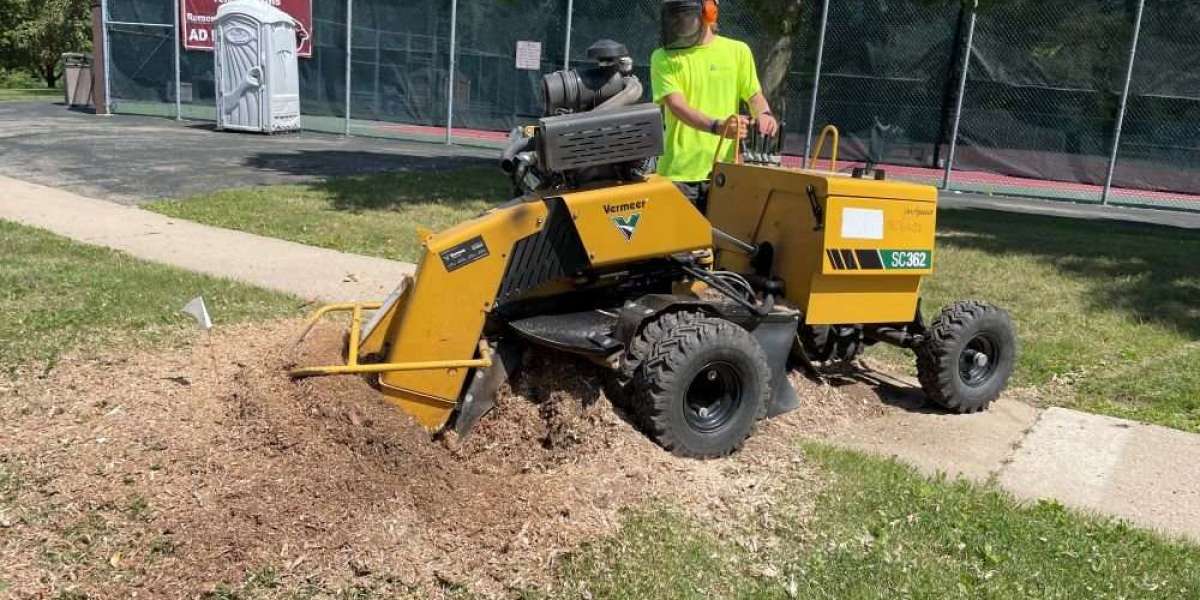Stump removal is a crucial service for homeowners looking to clear their yards of unwanted tree stumps. Tree stumps not only take up space but can also be a safety hazard, impede landscaping efforts, and become a breeding ground for pests. Professional stump removal services use a variety of tools and techniques to remove these stumps efficiently. In this article, we will explore the most commonly used tools and methods by stump removal experts.
1. Stump Grinding
Stump grinding is one of the most popular methods used by stump removal services. This technique involves the use of a stump grinder—a machine with a rotating blade that grinds the stump into small wood chips. Stump grinders come in different sizes, from smaller, handheld models to large, industrial-sized machines. The choice of grinder depends on the size and location of the stump.
How it works:
The grinder's blade is placed over the stump, and the machine begins to chew through the wood, chipping it away in small pieces. The operator moves the blade back and forth until the entire stump is ground down to a few inches below the surface of the ground. The result is a clean hole that can be filled with soil, making the area ready for replanting.
Advantages of Stump Grinding:
Fast and efficient
Leaves minimal mess as the wood chips can be used to fill the hole
Minimal disruption to the surrounding area
2. Stump Pulling
Stump pulling is another technique that can be used for removing tree stumps, especially smaller ones. This method involves using mechanical means, such as a winch or heavy equipment, to pull the stump out of the ground. Often, this process requires digging around the stump to expose the roots, which are then cut or loosened before the stump is pulled.
How it works:
After digging around the stump and cutting the major roots, a large vehicle or winch is attached to the stump. The equipment then pulls the stump from the ground, sometimes requiring significant force. The stump is then removed and discarded.
Advantages of Stump Pulling:
Effective for smaller stumps
Can be faster than grinding if the stump has shallow roots
Leaves the area clear of debris
3. Chemical Stump Removal
For homeowners who prefer a more natural or low-impact approach, chemical stump removal can be an option. This method uses chemicals that break down the stump over time, making it easier to remove manually or with the help of a stump grinder. Common chemicals used include potassium nitrate, which accelerates the decaying process.
How it works:
The chemical is applied to the stump after drilling holes into the wood. The chemical seeps into the wood and starts to break down the fibers, causing the stump to rot. This can take several months, depending on the size of the stump and environmental conditions.
Advantages of Chemical Stump Removal:
Less physically demanding
Can be a cheaper option compared to grinding or pulling
Good for stumps in hard-to-reach areas
Disadvantages:
Takes time—can take months for complete decomposition
Chemical residues may harm surrounding plants or soil
Not recommended for large stumps
4. Manual Stump Removal
Manual stump removal is often used for smaller stumps, particularly in situations where other methods may not be practical. This technique involves digging around the stump, cutting the roots, and physically pulling out the stump by hand.
How it works:
The process begins by digging a trench around the stump to expose the roots. Once the major roots are visible, they are cut or pried away. The stump is then pulled from the ground, and any remaining roots are dug up.
Advantages of Manual Stump Removal:
No heavy equipment is needed
Best for small to medium-sized stumps
No environmental impact from chemicals or machinery
Disadvantages:
Time-consuming
Physically demanding
Only suitable for small stumps
5. Excavation with Heavy Equipment
For large, stubborn stumps, heavy excavation equipment may be required. This method involves using large machinery like backhoes, bulldozers, or excavators to dig around and remove large stumps. Often, this is the only method for removing extremely large stumps or those that are deeply embedded in the soil.
How it works:
The machinery is used to dig around the stump, severing the roots and lifting the stump out of the ground. Once the stump is pulled out, the surrounding area is typically leveled and cleared of any large debris.
Advantages of Excavation:
Effective for large, deeply rooted stumps
Quick and efficient for large-scale removal
Works well in areas where grinding is not an option
Disadvantages:
Expensive due to the cost of heavy machinery
Can be damaging to the surrounding landscape
Not suitable for smaller stumps or residential areas with limited access
6. Burning the Stump
Burning is another method that some stump removal services use, though it is not as common. This technique involves burning the stump down to the ground using fire. It’s most effective in areas where fire hazards are not a concern and the stump has been properly prepared.
How it works:
The stump is drilled with holes, and a flammable substance is used to ignite the wood. The fire is kept burning until the stump is sufficiently burned down to the ground.
Advantages of Burning:
Can be an effective way to remove a stump without machinery
Less labor-intensive than digging or grinding
Disadvantages:
Risk of fire spreading
Not environmentally friendly
Requires permits in many areas
Conclusion
There are several tools and techniques used by stump removal services, each designed to suit different types of stumps and conditions. Whether it's stump grinding, pulling, chemical removal, or even excavation, professional stump removal services have the expertise and equipment to get the job done efficiently. For the best results, it’s important to choose a method that aligns with the size of the stump, location, and your budget. If you’re in need of stump removal services, consider reaching out to KC Stump Busters for reliable and effective solutions.








